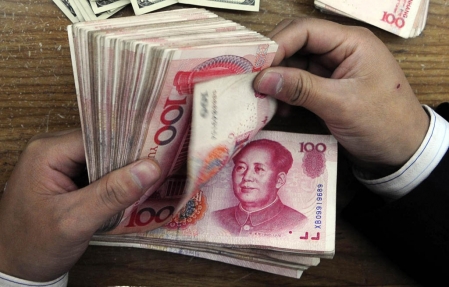Short-term borrowing rates in China have soared to record highs as credit seizes up, prompting fears that the country’s liquidity squeeze may be spinning out of control.
The Shibor overnight lending rate in Shanghai spiked violently to 29%, with wild moves in seven-day and one-month money. The central bank refused to intervene to calm markets, apparently determined to purge excess from the credit system.
China Securities Journal, a voice of the regulators, said: “We cannot use a fast money supply growth as in the past, or even faster, to promote economic growth.”
“I am extremely concerned about China,” said Lars Christensen from Danske Bank. “They are overdoing it and are on the verge of making the same mistake as the Fed and the European Central Bank before the Lehman crisis in 2008, when they failed to see how much the economy was slowing.”
Mr Christensen said the world now risks a “perfect storm” as the Fed prepares to taper its bond purchases (QE) at the same time as tightening the spigot of worldwide dollar liquidity.
The twin effects are cascading through emerging markets, pummelling commodity exporters such as Brazil, South Africa, and Russia that sell to China, but also tripping up Turkey, Ukraine, Hungary, and others that rely on external funding. “Everything is being hit indiscriminately,” said Neil Shearing from Capital Economics.
The Turkish lira and the Indian rupee both fell to record lows as investors pencilled in Fed tapering for September. “The party is over,” said Ceros Securities in Istanbul.
Fed chairman Ben Bernanke has brought forward the QE exit by lifting the unemployment target from 6.5% to 7%. He dismissed the looming threat of deflation as a “transitory” effect.
Brazil’s real weakened to a four-year low of 2.26 against the dollar, down 15% since April, while the cost of credit default swaps gauging risk in Indonesia and Vietnam jumped over 40 points. The Kremlin said Russian companies may have to delay bond issues, but denied immediate credit stress.
The latest country moving on to the radar screen is Poland, where construction crashed 28% in May. “Poland is suddenly stalling, something we haven’t seen in almost two decades. The central bank has been way too hawkish,” said Bartosz Pawlowski from BNP Paribas.
Benoit Anne from Societe Generale said the “second leg” of the emerging market sell-off is just starting, warning that there is a “long way” to go before investors wake up to the full impact of Fed tightening.
Latin America’s debt crisis of the early Eighties and East Asia’s crisis in the Nineties were both triggered by turns in the US credit cycle, though emerging markets have ample foreign reserves to defend themselves this time.
Mr Shearing said the BRICS quintet will be much weaker than assumed over the next two years for their own structural reasons, but there is now the risk of a “mutually reinforcing” effect as dollar stimulus drains away.
The latest ructions in China came after premier Li Keqiang omitted mention of the liquidity strains in a speech this week, instead dwelling on rampant excess in the shadow banking system and overcapacity in obsolete areas of the economy. Though Deutsche Bank said the unwinding of hot money inflows disguised by over-invoicing may also be to blame.
Mr Li’s comments were a signal that the new leadership intends to prick the credit bubble, even though the hard line has already led to industrial recession. China’s HSBC manufacturing index fell sharply in June, dropping further below the “boom-bust line” to 48.3.
Zhiwei Zhang from Nomura said Beijing aims to crack down on a plethora of trusts, wealth products, and off-shore vehicles intended to evade loan curbs. These have accounted for half China’s credit growth over the last year.
It is willing to “tolerate short-term pain” to wean China off over-investment, and is less worried about social instability now that its workforce has begun to contract and the rate of migrants from rural areas is slowing.
The strategy is to tighten before the Fed winds down QE in order to “avoid two negative shocks occurring simultaneously”, but this may be hard to manage given the scale of the boom. “We expect a painful deleveraging process in the next few months. Some defaults will likely occur in manufacturing industry and in non-bank financial institutions,” he said.
Fitch Ratings said total credit has jumped from $9 trillion to $23 trillion over the last five years, surging from 125% to 200% of GDP. This is a bigger rise than in any of the major bubbles worldwide over the last half century.
China has the fire-power to cope with any crisis and will not let the state banking system collapse. Keeping growth on track now that credit has reached saturation point is a tougher challenge.
World faces ‘perfect storm’ as liquidity dries up






























Laissez un commentaire Votre adresse courriel ne sera pas publiée.
Veuillez vous connecter afin de laisser un commentaire.
Aucun commentaire trouvé